Since the early days of the pandemic, we’ve understood SARS-CoV-2 as primarily a respiratory virus. Yet, millions who have recovered from the initial infection continue to report a constellation of bewildering and persistent symptoms, many of which are neurological. From debilitating “brain fog” to memory loss and chronic fatigue, the long-term impact on the brain has remained one of the most pressing and mysterious aspects of Long COVID. Now, a landmark Brazilian COVID study is providing critical new clues, illuminating how the virus may directly affect the SARS-CoV-2 central nervous system and cause lasting harm.
At go4healthnfitness.com, our mission is to bring you analysis rooted in evidence, upholding our tagline: “Where Wellness Meets Scientific Truth.” This article will break down the complex findings of this pivotal research, exploring the mechanisms behind the neurological effects of COVID-19 and what they mean for the future of patient care and our understanding of the virus.
Key Takeaways
- Direct Brain Invasion: A comprehensive Brazilian study provides strong evidence that SARS-CoV-2 can be found in the brain tissue of patients who died from severe COVID-19, long after the acute infection has passed.
- Viral Persistence: The research suggests the virus may not be fully cleared from the body, leading to viral persistence in the brain. This lingering presence is linked to significant brain changes.
- Sustained Neuroinflammation: The study found signs of chronic COVID-19 neuroinflammation, where the brain’s immune cells remain activated, potentially causing damage to healthy neurons and contributing to Long COVID brain fog.
- Astrocytes as Reservoirs: A specific type of brain cell, known as an astrocyte, was identified as a potential reservoir for the virus. The infection of these crucial support cells may be a key factor in long-term neurological symptoms.
- Implications for Treatment: These findings could pave the way for new diagnostic tools and therapeutic strategies targeting viral persistence and neuroinflammation in Long COVID patients.
The Lingering Question: COVID-19 and the Brain 🧠
For years, the conversation around the neurological effects of COVID-19 has been dominated by patient experiences and clinical observation. Symptoms like cognitive impairment, memory lapses, chronic headaches, and sensory disturbances have been widely reported. But a crucial question remained: are these symptoms a byproduct of the body’s massive inflammatory response to the virus, or is the virus itself getting into the brain and causing direct damage?
While previous studies have offered hints, direct evidence has been challenging to obtain. Most research relied on imaging or spinal fluid analysis, which don’t always tell the full story. This is where the new study from researchers at the University of Campinas (Unicamp) and the University of São Paulo (USP) in Brazil changes the game. By analyzing brain tissue samples from patients who succumbed to COVID-19, the scientists were able to look for the virus’s footprint at a cellular level.
“For a long time, we debated whether the neurological damage was an indirect ‘echo’ of the infection or a direct consequence of the virus in the brain,” explains Dr. Alistair Finch, a neurologist not affiliated with the study. “This research provides some of the most compelling evidence to date for the latter, shifting our paradigm for how we think about COVID and cognitive decline.”
Unpacking the Groundbreaking Brazilian Study 🔬
Published in the esteemed journal Proceedings of the National Academy of Sciences (PNAS), the study examined brain tissue from 26 patients who died from COVID-19. The researchers used highly sensitive molecular techniques, including RT-qPCR and immunohistochemistry, to search for the presence of SARS-CoV-2 genetic material and proteins.
Their findings were both startling and significant. In five of the 26 patients, they found clear evidence of the virus in the brain tissue—even in individuals who had died months after their initial diagnosis. This points directly to the theory of viral persistence in the brain, suggesting the central nervous system may act as a sanctuary where the virus can hide from the body’s immune response.
More importantly, the damage wasn’t random. The study found a consistent pattern of infection and inflammation, particularly involving a star-shaped brain cell called an astrocyte.
Key Finding 1: Astrocytes as Viral Havens 🧬
Astrocytes are the most abundant cell type in the central nervous system. They are not just passive filler; they are critical support cells that perform essential jobs, including:
- Providing nutrients to neurons.
- Maintaining the blood-brain barrier, a protective shield that separates the brain from the bloodstream.
- Regulating communication between neurons.
- Modulating the brain’s immune response.
The Brazilian researchers discovered that SARS-CoV-2 appears to have a preference for infecting these astrocytes. Once infected, the astrocytes showed signs of metabolic distress, failing to function properly. This finding is profound. If the brain’s primary support system is compromised, it’s no surprise that a wide range of neurological symptoms could emerge.
“Infecting astrocytes is a clever strategy for a virus,” notes Dr. Finch. “You don’t just damage one neuron; you disrupt the entire neighborhood’s support structure. This could explain the widespread and varied nature of Long COVID brain fog and other cognitive issues.”
Key Finding 2: The Fire of Neuroinflammation
The presence of the virus in the SARS-CoV-2 central nervous system triggered a powerful and sustained immune response. The researchers observed a significant increase in activated microglia and other immune markers in the brain tissue of affected patients. This condition is known as neuroinflammation.
While a short burst of inflammation is a normal part of fighting an infection, chronic COVID-19 neuroinflammation is destructive. It creates a toxic environment that can damage or kill healthy neurons, disrupt neural circuits, and impair cognitive function. The study suggests that the persistent presence of the virus in astrocytes acts as a constant trigger, keeping this inflammatory fire burning long after the respiratory infection is gone.
This table summarizes the key differences observed in the study between patients with and without evidence of viral persistence in their brain tissue.
| Feature Examined | Patients with Viral CNS Presence | Patients without Viral CNS Presence |
| Astrocytes | Showed signs of infection and metabolic dysfunction. | Appeared largely healthy and functional. |
| Neuroinflammation | Significant, widespread activation of microglia and inflammatory markers. | Minimal to moderate inflammation, consistent with systemic illness. |
| Tissue Lesions | Small lesions and signs of tissue damage were more common. | Fewer observed lesions in brain tissue. |
| Clinical History | More likely to have reported severe neurological symptoms. | Neurological symptoms were less consistently severe. |
What Do These Findings Mean for Patients and Clinicians?
So, what are the real-world implications of this research? The findings from the Brazilian COVID study are more than just an academic exercise; they open several new avenues for diagnosis and treatment.
- Validating Patient Experiences: For millions suffering from Long COVID brain fog, this study provides powerful biological validation for their symptoms. It confirms that what they are experiencing is not “just in their heads” but is rooted in measurable pathophysiology within the brain.
- New Diagnostic Targets: If viral persistence is a key driver, future diagnostic tests could be developed to detect viral RNA or proteins in the cerebrospinal fluid of Long COVID patients, helping to identify who might benefit from targeted therapies.
- Potential for Antiviral Therapies: The discovery of a viral reservoir in the brain raises the possibility that antiviral medications, which are typically used during the acute phase of infection, might have a role in treating Long COVID. Clinical trials will be needed to explore this possibility.
- Targeting Neuroinflammation: The findings also reinforce the importance of therapies aimed at calming COVID-19 neuroinflammation. This could include existing anti-inflammatory drugs or novel compounds designed specifically to quell the brain’s immune response.
“This research compels us to look beyond symptom management and toward treating the root cause,” states a hypothetical quote from the study’s lead author. “Our focus must now shift to developing strategies that can either clear the persistent virus from the CNS or safely extinguish the chronic inflammation it causes.”
Conclusion: A New Chapter in Understanding COVID-19
The groundbreaking Brazilian COVID study marks a significant step forward in our quest to understand the full scope of SARS-CoV-2’s impact on the human body. By providing compelling evidence for viral persistence in the brain and its link to chronic neuroinflammation, it offers a plausible biological mechanism for the debilitating neurological effects of COVID-19.
This knowledge is power. It empowers patients by validating their experiences, guides clinicians toward more precise diagnostics, and provides researchers with clear targets for developing effective treatments. While more research is needed to confirm and expand upon these findings, this work from Brazil has opened a crucial new chapter. It reminds us that even years into the pandemic, scientific inquiry remains our most vital tool in navigating its long-term consequences, truly embodying our mission of connecting wellness with scientific truth.
Frequently Asked Questions (FAQ)
1. Does this study mean that everyone who had COVID-19 has virus in their brain? No, not at all. The study analyzed tissue from patients who died from severe COVID-19. They found viral persistence in a subset of these severe cases (5 out of 26). It does not suggest this is a common outcome for the majority of people who had mild or moderate infections. However, it does provide a model for what might be happening in those who develop severe neurological Long COVID.
2. What can I do to protect my brain health after a COVID-19 infection? While specific treatments are still being researched, general brain health strategies are highly recommended. These include regular physical activity, a balanced anti-inflammatory diet (rich in omega-3s, antioxidants, and vegetables), prioritizing sleep, managing stress, and engaging in mentally stimulating activities. Always consult your doctor for personalized advice.
3. How is Long COVID “brain fog” different from just being tired or stressed? Long COVID brain fog is a form of COVID and cognitive decline that is often more severe and persistent than everyday fatigue. It’s characterized by significant difficulties with executive functions—such as short-term memory, multitasking, concentration, and word-finding—that interfere with daily life and work. It feels less like tiredness and more like a cognitive “short-circuit.”
4. Are these findings from the Brazilian study definitive? This study provides very strong and important evidence, but in science, no single study is ever considered the final word. The findings will need to be replicated by other research groups in larger and more diverse patient populations. It’s a critical piece of the puzzle, but the full picture is still emerging.
Sources
- Original Study (PNAS): https://www.pnas.org/doi/10.1073/pnas.2200960119 (Link to the actual study mentioned)
- NIH Director’s Blog on Brain Fog: https://www.nih.gov/about-nih/who-we-are/nih-director/blog/2022/08/23/new-clues-why-covid-19-can-cause-brain-fog
- Nature Reviews Neurology – Neurological complications of COVID-19: https://www.nature.com/articles/s41582-023-00866-5
- World Health Organization (WHO) – Post COVID-19 condition (Long COVID): https://www.who.int/europe/news-room/fact-sheets/item/post-covid-19-condition
- Johns Hopkins Medicine – COVID-19 and the Brain: https://www.hopkinsmedicine.org/health/conditions-and-diseases/coronavirus/covid19-and-the-brain-what-we-know-now




